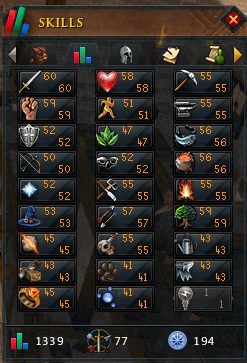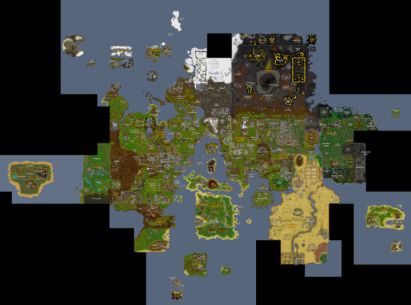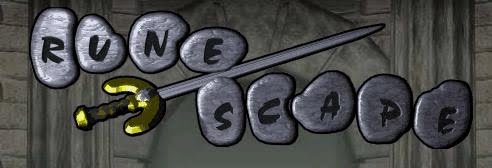Almost every gamer I know has at some point in their gaming ventures stepped into the expansive world of MMOs. They are notoriously known for their addictive core gameplay elements and constant updates that keep even long-time players hooked. They are both the best and worst types of games to play at times. Best because the worlds and characters presented in them are diverse and explored in depth and worst because they are often a huge time-sink and make it hard (at least personally) to play other games if you want to progress within the game. Most modern MMOs like Elder Scrolls have all the latest graphics and customisation options and a lot of people swear by them and while I have ventured into these MMOs on occasion and am stunned by the visual aspects, no MMO to date has caught my attention and kept it like Runescape has. While Runescape is certainly one of the older MMOs and until recently didn’t look as nice as World of Warcraft or Elder Scrolls, it has a lot of depth and charm behind it.
Runescape was developed by three brothers (Andrew Gower, Paul Gower and Ian Gower/Jagex) from Britain for a university project and started as a text-based MUD called DeviousMUD in the late 1990’s. DeviousMUD was later reworked into what is known as Runescape (aka Runescape Classic) in 2001 and was again reworked into the familiar version we know today in 2004. Runescape like most other MMOs, involves creating an avatar character and going around the in-game world killing monsters and completing quests while leveling up your character and getting access to better weapons and armour which are often dropped by high level bosses. However that is where the similarities stop. In most other MMOs you have to choose a class which predetermines what sort of character you make and what attack style you use, Runescape is clever in that you start off with a character that has no predetermined stats and begin at combat level-3. The three combat styles available to you are Ranged, Melee and Magic with each of these having weapons and armour that suit particular sub-styles within these combat styles. These all start off at level 1 and you can decide to train them all up evenly so you can switch between all the different combat styles at any time or just focus on one or two combat styles. This brings a lot of versatility to how you play the game which means you won’t get bored creating new characters just to try out a new combat style and so you can focus your energy on the one character as a whole. As well as your combat skills, you have other support or artisan skills which can help you with getting through the game.
Runescape is unique in that you don’t have to pay a subscription fee in order to play the content. The free-to-play experience gives you access to over half of the skills in the game (16 out of 27) and a handful of quests that will help you get the hang of the game. In free-to-play you do have a smaller area to explore but there is still enough content to keep you going for a while should you not want to get membership. You can even accumulate a certain amount of in-game money and pay for your membership through Bonds so that you don’t have to pay out of your own pocket. Personally, I would recommend getting through the free-to-play content first and then moving onto membership as that is where all the fun really begins. Once you do get membership, the in-game world opens up and you are able to travel to dark lands inhabited by werewolves and vampires right through to majestic areas inhabited by fairies and mountainous terrains inhabited by dwarves. As previously mentioned, you get access to 27 skills and over 200 quests with more being added over time by Jagex. You also get access to many different types of bosses with interesting battles and can complete certain tasks or mini-quests that give you access to rewards that help you get your levels up quicker. Needless to say there is plenty of content to keep you invested in this game.

As with any good MMO, it needs to have engaging stories that shed light on the lore of the land to allow you to be fully immersed in the game. Runescape is set in Gielinor, an earth-like planet with a medieval setting with many colourful characters that tell stories of ancient civilisations, historical figures and the many Runescape gods and their factions through quests. Back when I started playing the game in late 2004, the game had only touched on a few gods such as Guthix, Zamorak and Saradomin and not much was known about them until 2013 when Jagex released a quest where the gods were able to re-emerge and now they are at the forefront of the game’s story. What I find quite remarkable is that most of the quests are interconnected in some way and that most of them have led to the events that are happening today. The world of Gielinor is on the verge of war with the gods and the adventurer (your character) is at the forefront. This sets the pace for Jagex to continually release high-quality content and continue Runescape’s story.

Almost as important as having engaging stories, MMOs need to have an appropriate soundtrack and graphics that can create a vibrant and memorable environment for the player to explore and Runescape certainly delivers. Runescape boasts over 1000 unique music tracks all designed to capture the feel of the areas that you travel to in-game or capture really tense moments against tough monsters or opponents. I personally love the honky-tonk music that plays when you walk into a Runescape pub and the spooky music that plays when you are in an area infested by vampires and werewolves. Accompanying these music tracks are sound effects like birds chirping or beer glasses clinking that add to the ambience of the area you are located in. With the recent release of the Runescape’s new graphics engine, codenamed “NXT”, the world of Gielinor looks better than ever. The rivers in Runescape have realistic-looking water and you can now see more of the world around you by zooming out. While the new system can sometimes cause the game to glitch out, it is still a vast improvement on what Runescape used before. Runescape may not look as good as other MMOs such as Elder Scrolls but it is still a pleasure to wander around.
Graphics, soundtracks and gameplay are all important elements in an MMO but what sets an MMO apart from others is its ability to evolve and adapt as the years progress without losing its core gameplay or story and while there have been a few controversial updates scattered throughout its history, Runescape has managed to stand the test of time. Back when I first started playing in late 2004, Runescape was still using a JAVA-based engine with polygonal shapes and pixellated landscapes. Over time however, Runescape has seen many graphical updates from updated monster and character designs right through to multiple town reworks and general updates to the game engine with the biggest being the move from a JAVA based client to the NXT client. Back when I started playing, obtaining rarer items was difficult as well as this was done solely through player interaction or getting rare drops from monsters if you were lucky. This was until late 2007 when the Grand Exchange was released which changed the game dramatically. The Grand Exchange allows players to put the items they want to sell in a marketplace and allows other players to obtain the items they want by simply searching it and hoping that someone has placed that item for selling in the Grand Exchange. While this was a necessary update and has certainly made the game feel like less of a grind, I feel that some of the old social aspects of the game were thrown out the window as now a player can essentially avoid player interaction using this system. However one of the most controversial updates to date would have to be the Evolution of Combat which was essentially a complete overhaul of the old combat system on Runescape. Before the Evolution of Combat, combat involved clicking on a monster and sitting back and waiting passively while your character and monster fought back and forth until the monster’s health went all the way down. The Evolution of Combat gave players access to abilities and more strategic ways to defeat your opponents whether it be monsters or other players and also balanced out the combat triangle significantly as beforehand the game had an unfair advantage for melee based characters. When this update first came out, I had my doubts like a lot of other people did but the more I got used to it, the more the old combat method seemed stale and passive. Jagex needed to release this update to bring the game into the modern age of MMOs. This update however did divide the community significantly and led Jagex to create different game modes to try to accommodate the players that didn’t like the update such as Old School Runescape (a backup server state from 2007) and Ironman Mode (where you are fully self-sufficient and don’t get help from other players or the Grand Exchange) which was commendable. Overall the game continues to evolve over time and I personally look forward to seeing where it goes.
While the game of Runescape isn’t perfect by any means, it certainly has come a long way from when it first started. There is heaps of content that will keep you entertained for hours and plenty of environments for you to wander through that make the game a very pleasant experience. With constant updates at least two to three times a month, there is always more content being added to the game to keep you playing. Runescape is a delightful and fun MMO to play and if you liked what you read about it in this review I would encourage you to check this game out.








